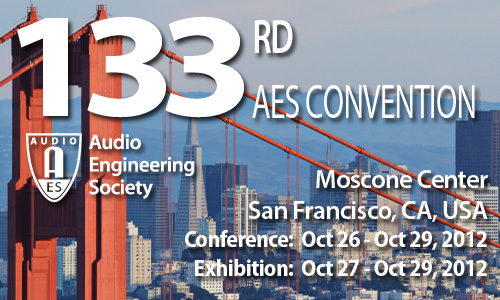
AES San Francisco 2012
Paper Session P2
P2 - Networked Audio
Friday, October 26, 9:00 am — 10:30 am (Room 122)
Chair:
Ellen Juhlin, Meyer Sound - Berkeley, CA, USA; AVnu Alliance
P2-1 Audio Latency Masking in Music Telepresence Using Artificial Reverberation—Ren Gang, University of Rochester - Rochester, NY, USA; Samarth Shivaswamy, University of Rochester - Rochester, NY, USA; Stephen Roessner, University of Rochester - Rochester, NY, USA; Akshay Rao, University of Rochester - Rochester, NY, USA; Dave Headlam, University of Rochester - Rochester, NY, USA; Mark F. Bocko, University of Rochester - Rochester, NY, USA
Network latency poses significant challenges in music telepresence systems designed to enable multiple musicians at different locations to perform together in real-time. Since each musician hears a delayed version of the performance from the other musicians it is difficult to maintain synchronization and there is a natural tendency for the musicians to slow their tempo while awaiting response from their fellow performers. We asked if the introduction of artificial reverberation can enable musicians to better tolerate latency by conducting experiments with performers where the degree of latency was controllable and for which artificial reverberation could be added or not. Both objective and subjective evaluation of ensemble performances were conducted to evaluate the perceptual responses at different experimental settings.
Convention Paper 8688 (Purchase now)
P2-2 Service Discovery Using Open Sound Control—Andrew Eales, Wellington Institute of Technology - Wellington, New Zealand; Rhodes University - Grahamstown, South Africa; Richard Foss, Rhodes University - Grahamstown, Eastern Cape, South Africa
The Open Sound Control (OSC) control protocol does not have service discovery capabilities. The approach to adding service discovery to OSC proposed in this paper uses the OSC address space to represent services within the context of a logical device model. This model allows services to be represented in a context-sensitive manner by relating parameters representing services to the logical organization of a device. Implementation of service discovery is done using standard OSC messages and requires that the OSC address space be designed to support these messages. This paper illustrates how these enhancements to OSC allow a device to advertise its services. Controller applications can then explore the device’s address space to discover services and retrieve the services required by the application.
Convention Paper 8689 (Purchase now)
P2-3 Flexilink: A Unified Low Latency Network Architecture for Multichannel Live Audio—Yonghao Wang, Birmingham City University - Birmingham, UK; John Grant, Nine Tiles Networks Ltd. - Cambridge, UK; Jeremy Foss, Birmingham City University - Birmingham, UK
The networking of live audio for professional applications typically uses layer 2-based solutions such as AES50 and MADI utilizing fixed time slots similar to Time Division Multiplexing (TDM). However, these solutions are not effective for best effort traffic where data traffic utilizes available bandwidth and is consequently subject to variations in QoS. There are audio networking methods such as AES47, which is based on asynchronous transfer mode (ATM), but ATM equipment is rarely available. Audio can also be sent over Internet Protocol (IP), but the size of the packet headers and the difficulty of keeping latency within acceptable limits make it unsuitable for many applications. In this paper we propose a new unified low latency network architecture that supports both time deterministic and best effort traffic toward full bandwidth utilization with high performance routing/switching. For live audio, this network architecture allows low latency as well as the flexibility to support multiplexing multiple channels with different sampling rates and word lengths.
Convention Paper 8690 (Purchase now)
